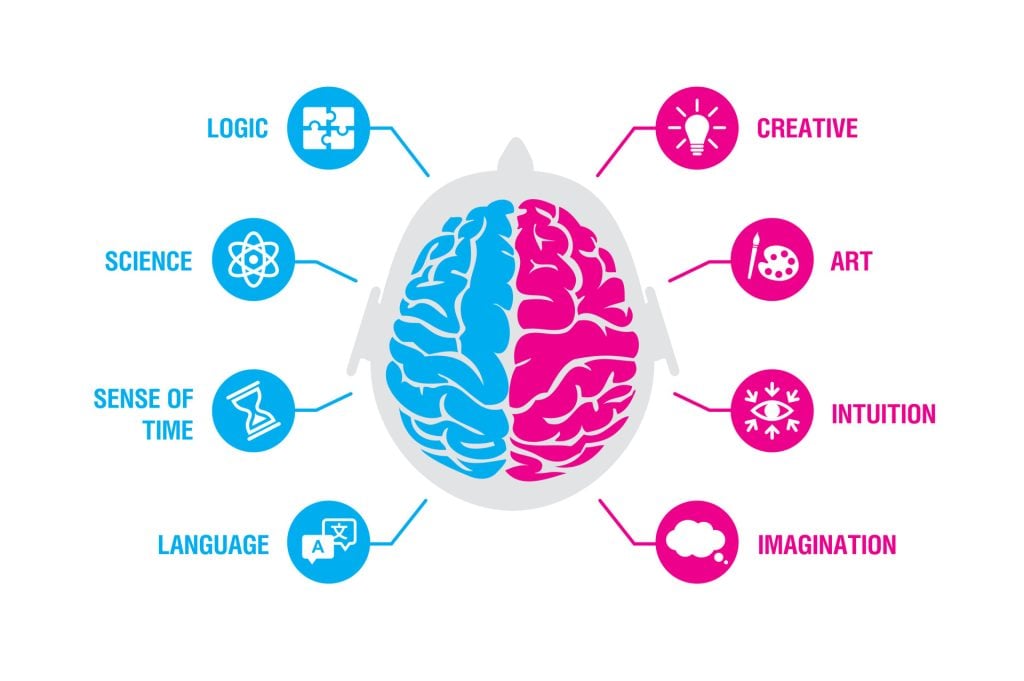
Hemispheric lateralization is the idea that both brain hemispheres are functionally different and that specific mental processes and behaviors are mainly controlled by one hemisphere rather than the other.
Left hemisphere function
The left hemisphere controls the right-hand side of the body and receives information from the right visual field, controlling speech, language, and recognition of words, letters, and numbers.
Right hemisphere function
The right hemisphere controls the left-hand side of the body and receives information from the left visual field, controlling creativity, context, and recognition of faces, places, and objects.
According to the left-brain, right-brain dominance theory, the left side of the brain is considered to be adept at tasks that are considered logical, rational, and calculating.
By contrast, the right side of the brain is best at artistic, creative, and spontaneous tasks (Corballis, 2014; Joseph, 1988).
Brain Lateralization
Brain lateralization has become a somewhat controversial topic. While evidence supports some mental capacity occurring predominantly on one side of the brain or the other, science has overturned several earlier notions relating to this topic.
Psychologists now consider functions like language, spatial processing, and certain broader tasks to have lateralization. Language uses several brain modules, many of which are situated on the left side of the brain (Taylor, 1990).
In fact, language represents one of the main areas of interest for brain lateralization and the function for which this neurological division was first found. Even the language neurons, however, may also be split among both halves of the brain (Riès et al., 2016), or located on the right side, which is more common in left-handed people (Beaumont, 2008).
The left side of the brain often contains language-processing regions such as Broca’s Area, which produces understandable sentences, as well as Wernicke’s area, which understands speech (Griggs, 2010).
Injuries to these areas result in speech pathologies, such as an inability to speak or usually listen (Broca, 1865; Pinel & Barnes, 2017). Other language functions, like associating emotions with phrases, occur on the right side of the brain (Kandel et al., 2012).
As such, language can be seen as bridging together both halves of the brain, but with some specific functionality located on one side or the other (Riès et al., 2016). Scientists have studied language, memory, and other topics through various methods, such as the “Wada test.”
This involves disabling one side of the brain chemically, then observing how the other side operates. Logical thinking, like language, often resides primarily on the left side of the brain (Dehaene, 1999).
Again, this applies more often to right-handed people, with the reverse holding true for many left-handed people. The right brain, by contrast, has more active involvement than the left in visual or spatial processing.
As such, this works while drawing, navigating around a room, or in other comparable situations. People who have right brain injuries may become clumsy or artistically inept (McGilchrist, 2019). The right brain also becomes active while recognizing faces.
As with other functionalities, there is some degree of symmetry. The left brain can also do facial recognition, but it is more perfunctory than the right brain’s work. The right brain deals with other social perception, too, like body posture (Lane & Nadel, 2002).
Another feature of the right brain is to focus one’s attention. When a person thinks about one topic, this lights up regions on the right side of the brain. Numerous other mental activities operate differently on each side of the brain.
For example, the left brain is more associated with positive emotions, while the right brain is more associated with negative emotions (Lane & Nadel, 2002). People with depression often suffer from a disproportionate ratio of right-to-left brain activity (Atchley et al., 2003; Hecht, 2010).
Comparing the left versus right sides of the brain, the left brain processes new information into an understanding of events (making it the “interpreter”), while the right brain accounts for social behaviors.
For example, the left brain may assess which actions would lead to eating food, while the right brain may nix some of these actions on the basis of social norms (one doesn’t just run through a crowd at a party to grab food).
The left brain can be seen as an analyst, breaking apart concepts into smaller, manageable chunks. By contrast, the right brain can be seen as a synthesist, developing a more cohesive view (McGilchrist, 2019).
Interestingly, the lateralization of the brain has deeper roots in the peripheral nervous systems (Craig 2005). Nerves throughout the body feed into and out of the brain.
The left brain largely receives connections from the parasympathetic system, while the right brain largely receives connections from the sympathetic system (Conesa 1995).
Together, the two halves of the brain work with the rest of the nervous system to maintain a homeostatic balance.
The two sides of the brain are connected together by several components called “commissural nerve tracts”, largely the corpus callosum.
This segment bridges the left and right brains, sharing information. In rare cases, people are born without the corpus callosum or have it surgically removed to reduce epileptic seizures.
These cases have revealed interesting information about the two halves of the brain. In people without a corpus callosum, the brain can reorganize to perform functions normally occurring on one side instead of the other.
This may even result in the person developing the use of brain regions on both sides for the same task, allowing, for example, a person to read two texts simultaneously, one on each side of the brain.
The brain can also reorganize itself under other conditions (Gómez-Robles et al., 2013). Often this involves using either a nearby region or a mirror opposite region to replace lost function. This shows how the brain structure has largely symmetrical functionality on the left versus right halves.
There are, however, some slight differences. The body is connected to the brain, so senses as well as control usually take place on the opposite side. The left brain senses and controls the right hand, the right foot, the right half of the visual field, the right ear, and so forth.
Scientists discovered this by electrically probing the brain and observing the body’s responses, which produced a map of the body’s associations in the brain.
The motor cortex produces motions for the opposite side. In right-handed people, the left motor cortex is usually larger than the right motor cortex. Left-handed people, by contrast, often have right-brain dominance.
In addition, some people are ambidextrous (able to use both sides effectively) or have mixed dominance (using the left side for some activities but the right side for others).
The brain evolved to have some asymmetry (Vallortigara & Rogers, 2005), which occurs at multiple levels, from the basic cell arrangements differing on each side to the right hemisphere sitting slightly forward of the left hemisphere (called Yakovlevian torque).
Numerous specific brain regions, like the parietal operculum or the central sulcus, have left-right asymmetry. People who have less brain asymmetry may suffer from less effective thought processes, even schizophrenia or mood disorders (Sun et al., 2015; Ribolsi et al., 2014).
Numerous other disorders also have bases in left-right brain problems (Royer et al., 2015). In one contentious theory, called bicameralism, the left-right human brain evolved only over the last three thousand years or so from having two different identities within it.
One of these minds would speak, issuing commands, while the other mind would listen, obeying. Split-brain patients often act as though they have two minds, which some neuroscientists argue may be the case (called “dual consciousness”).
For example, one side of the body may work to prevent the other side of the body from acting. This would put a more literal spin on the phrase “being of two minds.”
Research
Roger W. Sperry, a twentieth-century neuroscientist, made numerous contributions to the understanding of the twin halves of the brain.
Sperry (1967) conducted investigations on split-brain patients, people whose left and right brains lack the normal connections between them. These people sometimes exhibit brain-side dominance, but they also display a range of distinctive behaviors from only one side or the other.
Sperry also studied animal subjects, rewiring their nervous systems to send signals to the opposite side of the body. This showed how some mental features have hard wiring on one side of the brain while other mental features can adapt to function correctly on either side of the brain.
Sperry’s work revealed that the left side of the brain contains critical modules for producing sentences but that the right side of the brain retains some language capacities, such as understanding the social context of speech.
The psychology of left brain versus right brain dominance indicates that humans have brains with overlapping yet distinct halves.
Critical Evaluation
How lateralized are brain functions? Not nearly as much as people often think. While one’s brain lateralization can affect personality, this only has a small part in the overall development of an individual.
People generally use both sides of the brain equally. There are, however, numerous specific brain regions on either the left or right side, which can have powerful effects.
For example, a person who had part of the right prefrontal lobe removed became incapable of valuing long-term rewards over short-term considerations, while people with regions of the left brain removed exhibit different symptoms (Lane & Nadel, 2002).
The two sides of the brain have somewhat different contributions in many ways: how one thinks, how one perceives other people and the environment, how one feels (both consciously and unconsciously), how mentally healthy one is, as well as countless other facets of personality and behavior.
Left-handed people have right brain dominance for body control, which may also result in the more artistic personality for which such people are known. However, as can be seen by the fact that there are numerous right-handed artists as well as left-handed rational thinkers, brain lateralization only goes so far.
The notion of left-brain versus right-brain dominance has some basis, but it represents a false dichotomy. The complexity of the brain involves features on both sides working together, often communicating with each other through the center (Beaumont, 2008).
Many mental functions require both sides of the brain to work in unison, undermining the claim that either side outdoes the other. As a whole, the brain remains poorly understood, with scientists continuing to investigate (Halpern, 2005).
What we do know about left-brain versus right-brain dominance is that it seems to have specific patterns, such as language or logic often occurring in the left brain or emotion and social cognition often occurring in the right brain.
However, these sides can be reversed in individuals or more balanced between both sides. Also, all of these functionalities have at least some equivalent on the opposite side of the brain.
The brain has plasticity, and in cases such as injury, it will recruit other regions which can easily be located on the opposite side (Pulsifer, 2004).
However, each brain is unique. Some have different lateralization than others, and the location of functions can even develop during the course of one’s life.
FAQs
What does the right side of the brain control?
The right side of the brain primarily controls spatial abilities, face recognition, visual imagery, music awareness, and artistic skills. It’s also linked to creativity, imagination, and intuition.
However, the concept of each brain hemisphere controlling distinct functions is an oversimplification; both hemispheres work together for most tasks.
What does the left side of the brain control?
The left side of the brain mainly controls logic-related tasks, such as science and mathematics, language processing, like grammar and vocabulary, and fact-based thinking. It’s also involved in analytical abilities and sequential processing.
Nevertheless, the notion of each brain hemisphere controlling distinct tasks is a simplification; in reality, both hemispheres collaborate for most activities.
References
Atchley, R. A., Ilardi, S. S., & Enloe, A. (2003). Hemispheric asymmetry in the processing of emotional content in word meanings: The effect of current and past depression. Brain and Language, 84 (1), 105–119.
Beaumont, G. J. (2008). Introduction to Neuropsychology (2nd ed.). The Guilford Press.
Broca, P. (1865). Sur le siège de la faculté du langage articulé. Bulletins de La Société d’anthropologie de Paris, 6 (1), 377–393.
Conesa, J. (1995). Electrodermal Palmar Asymmetry and Nostril Dominance. Perceptual and Motor Skills, 80 (1), 211–216.
Corballis, M. C. (2014). Left brain, right brain: facts and fantasies. PLoS Biol, 12 (1), e1001767.
Craig, A. D. B. (2005). Forebrain emotional asymmetry: a neuroanatomical basis? Trends in Cognitive Sciences, 9 (12), 566–571.
Dehaene, S. (1999). Sources of Mathematical Thinking: Behavioral and Brain-Imaging Evidence. Science, 284 (5416), 970–974.
Drew, W. (2020). Psychology. John Wiley & Sons.
Gómez-Robles, A., Hopkins, W. D., & Sherwood, C. C. (2013). Increased morphological asymmetry, evolvability and plasticity in human brain evolution. Proceedings of the Royal Society B: Biological Sciences, 280 (1761), 20130575.
Griggs, R. A. (2010). Psychology: A Concise Introduction (Third ed.). Worth Publishers.
Halpern, M. E. (2005). Lateralization of the Vertebrate Brain: Taking the Side of Model Systems. Journal of Neuroscience, 25 (45), 10351–10357.
Harenski, C. L., & Hamann, S. (2006). Neural correlates of regulating negative emotions related to moral violations. NeuroImage, 30 (1), 313–324.
Hecht, D. (2010). Depression and the hyperactive right-hemisphere. Neuroscience Research, 68 (2), 77–87.
Hines, T. (1987). Left Brain/Right Brain Mythology and Implications for Management and Training. The Academy of Management Review, 12 (4), 600.
Joseph, R. (1988). The right cerebral hemisphere: Emotion, music, visual‐spatial skills, body‐image, dreams, and awareness . Journal of Clinical Psychology, 44 (5), 630-673.
Kandel, E. R., Schwartz, J. H., Jessell, T. M., Siegelbaum, S. A., & Hudspeth, A. J. (2012). Principles of Neural Science, Fifth Edition (Principles of Neural Science (Kandel)) (5th ed.). McGraw-Hill Education / Medical.
Lane, R. D., & Nadel, L. (2002). Cognitive Neuroscience of Emotion (Series in Affective Science). Oxford University Press.
McGilchrist, I. (2019). The Master and His Emissary: The Divided Brain and the Making of the Western World (Second Edition, New Expanded ed.). Yale University Press.
Pinel, J. P. J., & Barnes, S. (2017). Biopsychology (10th Edition) (10th ed.). Pearson.
Pulsifer, M. B., Brandt, J., Salorio, C. F., Vining, E. P. G., Carson, B. S., & Freeman, J. M. (2004). The Cognitive Outcome of Hemispherectomy in 71 Children. Epilepsia, 45 (3), 243–254.
Ribolsi, M., Daskalakis, Z. J., Siracusano, A., & Koch, G. (2014). Abnormal Asymmetry of Brain Connectivity in Schizophrenia. Frontiers in Human Neuroscience, 8, 1010.
Riès, S. K., Dronkers, N. F., & Knight, R. T. (2016). Choosing words: left hemisphere, right hemisphere, or both? Perspective on the lateralization of word retrieval. Annals of the New York Academy of Sciences, 13 69(1), 111–131.
Royer, C., Delcroix, N., Leroux, E., Alary, M., Razafimandimby, A., Brazo, P., Delamillieure, P., & Dollfus, S. (2015). Functional and structural brain asymmetries in patients with schizophrenia and bipolar disorders. Schizophrenia Research, 161 (2–3), 210–214.
Sun, Y., Chen, Y., Collinson, S. L., Bezerianos, A., & Sim, K. (2015). Reduced Hemispheric Asymmetry of Brain Anatomical Networks Is Linked to Schizophrenia: A Connectome Study. Cerebral Cortex, bhv255.
Taylor, I. (1990). Psycholinguistics: Learning and Using Language (1st ed.). Pearson.
Toga, A. W., & Thompson, P. M. (2003). Mapping brain asymmetry. Nature Reviews Neuroscience, 4 (1), 37–48.
Vallortigara, G., & Rogers, L. (2005). Survival with an asymmetrical brain: advantages and disadvantages of cerebral lateralization. Behavioral and Brain Sciences, 28 (4), 575–589.
Further Reading
- Gainotti, G. (2014). Why are the right and left hemisphere conceptual representations different?. Behavioral neurology, 2014.
- Macdonald, K., Germine, L., Anderson, A., Christodoulou, J., & McGrath, L. M. (2017). Dispelling the myth: Training in education or neuroscience decreases but does not eliminate beliefs in neuromyths. Frontiers in Psychology, 8, 1314.
- Corballis, M. C. (2014). Left brain, right brain: facts and fantasies. PLoS Biol, 12(1), e1001767.
- Nielsen, J. A., Zielinski, B. A., Ferguson, M. A., Lainhart, J. E., & Anderson, J. S. (2013). An evaluation of the left-brain vs. right-brain hypothesis with resting state functional connectivity magnetic resonance imaging. PloS one, 8(8), e71275.

